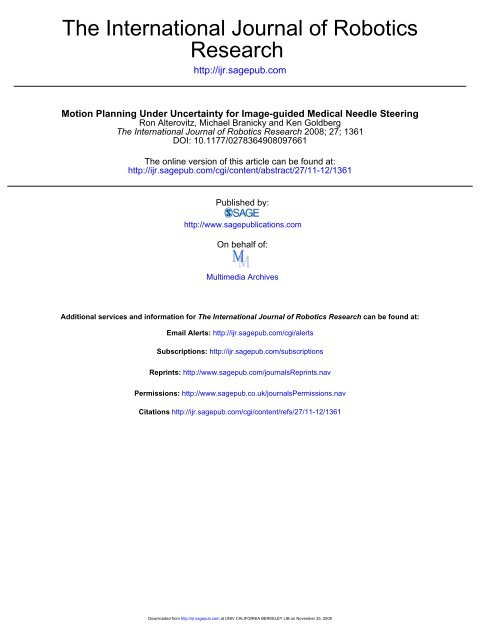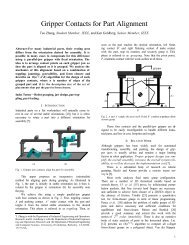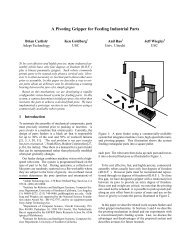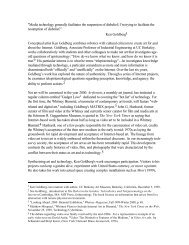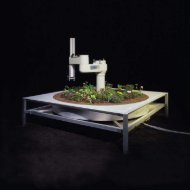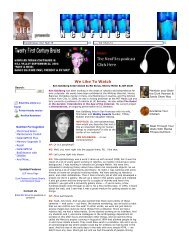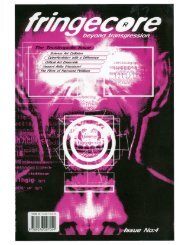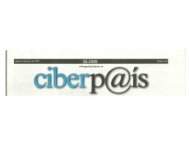0.5MB .pdf - Ken Goldberg - University of California, Berkeley
0.5MB .pdf - Ken Goldberg - University of California, Berkeley
0.5MB .pdf - Ken Goldberg - University of California, Berkeley
You also want an ePaper? Increase the reach of your titles
YUMPU automatically turns print PDFs into web optimized ePapers that Google loves.
The International Journal <strong>of</strong> Robotics<br />
Research<br />
http://ijr.sagepub.com<br />
Motion Planning Under Uncertainty for Image-guided Medical Needle Steering<br />
Ron Alterovitz, Michael Branicky and <strong>Ken</strong> <strong>Goldberg</strong><br />
The International Journal <strong>of</strong> Robotics Research 2008; 27; 1361<br />
DOI: 10.1177/0278364908097661<br />
The online version <strong>of</strong> this article can be found at:<br />
http://ijr.sagepub.com/cgi/content/abstract/27/11-12/1361<br />
Published by:<br />
http://www.sagepublications.com<br />
On behalf <strong>of</strong>:<br />
Multimedia Archives<br />
Additional services and information for The International Journal <strong>of</strong> Robotics Research can be found at:<br />
Email Alerts: http://ijr.sagepub.com/cgi/alerts<br />
Subscriptions: http://ijr.sagepub.com/subscriptions<br />
Reprints: http://www.sagepub.com/journalsReprints.nav<br />
Permissions: http://www.sagepub.co.uk/journalsPermissions.nav<br />
Citations http://ijr.sagepub.com/cgi/content/refs/27/11-12/1361<br />
Downloaded from<br />
http://ijr.sagepub.com at UNIV CALIFORNIA BERKELEY LIB on November 25, 2008
Ron Alterovitz<br />
Department <strong>of</strong> Computer Science,<br />
<strong>University</strong> <strong>of</strong> North Carolina at Chapel Hill,<br />
Chapel Hill, NC 27599-3175, USA<br />
ron@cs.unc.edu<br />
Michael Branicky<br />
Department <strong>of</strong> Electrical Engineering<br />
and Computer Science,<br />
Case Western Reserve <strong>University</strong>,<br />
Cleveland, OH 44106, USA<br />
mb@case.edu<br />
<strong>Ken</strong> <strong>Goldberg</strong><br />
Department <strong>of</strong> Industrial Engineering<br />
and Operations Research,<br />
Department <strong>of</strong> Electrical Engineering<br />
and Computer Sciences,<br />
<strong>University</strong> <strong>of</strong> <strong>California</strong>,<br />
<strong>Berkeley</strong>, CA 94720, USA<br />
goldberg@berkeley.edu<br />
Abstract<br />
We develop a new motion planning algorithm for a variant <strong>of</strong> a Dubins<br />
car with binary left/right steering and apply it to steerable needles,<br />
a new class <strong>of</strong> flexible bevel-tip medical needle that physicians can<br />
steer through s<strong>of</strong>t tissue to reach clinical targets inaccessible to traditional<br />
stiff needles. Our method explicitly considers uncertainty in<br />
needle motion due to patient differences and the difficulty in predicting<br />
needle/tissue interaction. The planner computes optimal steering<br />
actions to maximize the probability that the needle will reach the desired<br />
target. Given a medical image with segmented obstacles and<br />
target, our method formulates the planning problem as a Markov decision<br />
process based on an efficient discretization <strong>of</strong> the state space,<br />
models motion uncertainty using probability distributions and computes<br />
optimal steering actions using dynamic programming. This approach<br />
only requires parameters that can be directly extracted from<br />
images, allows fast computation <strong>of</strong> the optimal needle entry point and<br />
enables intra-operative optimal steering <strong>of</strong> the needle using the precomputed<br />
dynamic programming look-up table. We apply the method<br />
The International Journal <strong>of</strong> Robotics Research<br />
Vol. 27, No. 11–12, November/December 2008, pp. 1361–1374<br />
DOI: 10.1177/0278364908097661<br />
cSAGE Publications 2008 Los Angeles, London, New Delhi and Singapore<br />
Figures 1, 5–6, 8–9 appear in color online: http://ijr.sagepub.com<br />
Motion Planning Under<br />
Uncertainty for<br />
Image-guided Medical<br />
Needle Steering<br />
to generate motion plans for steerable needles to reach targets inaccessible<br />
to stiff needles, and we illustrate the importance <strong>of</strong> considering<br />
uncertainty during motion plan optimization.<br />
KEY WORDS—motion planning, medical robotics, uncertainty,<br />
needle steering, dynamic programming, Markov decision<br />
process, image-guided medical procedure<br />
1. Introduction<br />
Downloaded from<br />
http://ijr.sagepub.com at UNIV CALIFORNIA BERKELEY LIB on November 25, 2008<br />
Advances in medical imaging modalities such as magnetic resonance<br />
imaging (MRI), ultrasound and X-ray fluoroscopy are<br />
now providing physicians with real-time, patient-specific information<br />
as they perform medical procedures such as extracting<br />
tissue samples for biopsies, injecting drugs for anesthesia,<br />
or implanting radioactive seeds for brachytherapy cancer treatment.<br />
These diagnostic and therapeutic medical procedures require<br />
the insertion <strong>of</strong> a needle to a specific location in s<strong>of</strong>t tissue.<br />
We are developing motion planning algorithms for medical<br />
needle insertion procedures that can utilize the information<br />
obtained from real-time imaging to accurately reach desired<br />
locations.<br />
We consider a new class <strong>of</strong> medical needles, composed <strong>of</strong> a<br />
flexible material and with a bevel-tip, that can be steered to targets<br />
in s<strong>of</strong>t tissue that are inaccessible to traditional stiff needles<br />
(Alterovitz et al. 2005a,b Webster et al. 2005a, 2006a).<br />
1361
1362 THE INTERNATIONAL JOURNAL OF ROBOTICS RESEARCH / November/December 2008<br />
Steerable needles are controlled by two degrees <strong>of</strong> freedom actuated<br />
at the needle base: the insertion distance and the bevel<br />
direction. Webster et al. (2006a) experimentally demonstrated<br />
that, under ideal conditions, a flexible bevel-tip needle cuts a<br />
path <strong>of</strong> constant curvature in the direction <strong>of</strong> the bevel, and the<br />
needle shaft bends to follow the path cut by the bevel tip. In a<br />
plane, a needle subject to this non-holonomic constraint based<br />
on bevel direction is equivalent to a Dubins car that can only<br />
steer its wheels far left or far right but cannot go straight.<br />
The steerable needle motion planning problem is to determine<br />
a sequence <strong>of</strong> actions (insertions and direction changes)<br />
so that the needle tip reaches the specified target while avoiding<br />
obstacles and staying inside the workspace. Given a segmented<br />
medical image <strong>of</strong> the target, obstacles and starting location,<br />
the feasible workspace for motion planning is defined<br />
by the s<strong>of</strong>t tissues through which the needle can be steered.<br />
Obstacles represent tissues that cannot be cut by the needle,<br />
such as bone, or sensitive tissues that should not be damaged,<br />
such as nerves or arteries.<br />
We consider motion planning for steerable needles in the<br />
context <strong>of</strong> an image-guided procedure: real-time imaging and<br />
computer vision algorithms are used to track the position and<br />
orientation <strong>of</strong> the needle tip in the tissue. Recently developed<br />
methods can provide this information for a variety <strong>of</strong> imaging<br />
modalities (Cleary et al. 2003 DiMaio et al. 2006a). In this<br />
paper, we consider motion plans in an imaging plane since<br />
the speed/resolution trade-<strong>of</strong>f <strong>of</strong> three-dimensional imaging<br />
modalities is generally poor for three-dimensional real-time<br />
interventional applications. With imaging modalities continuing<br />
to improve, we will explore the natural extension <strong>of</strong> our<br />
planning approach to three dimensional in future work.<br />
Whereas many traditional motion planners assume a robot’s<br />
motions are perfectly deterministic and predictable, a needle’s<br />
motion through s<strong>of</strong>t tissue cannot be predicted with certainty<br />
due to patient differences and the difficulty in predicting needle/tissue<br />
interaction. These sources <strong>of</strong> uncertainty may result<br />
in deflections <strong>of</strong> the needle’s orientation, which is a type <strong>of</strong><br />
slip in the motion <strong>of</strong> a Dubins car. Real-time imaging in the<br />
operating room can measure the needle’s current position and<br />
orientation, but this measurement by itself provides no information<br />
about the effect <strong>of</strong> future deflections during insertion.<br />
Since the motion response <strong>of</strong> the needle is not deterministic,<br />
success <strong>of</strong> the procedure can rarely be guaranteed.<br />
We develop a new motion planning approach for steering<br />
flexible needles through s<strong>of</strong>t tissue that explicitly considers<br />
uncertainty in needle motion. To define optimality for a needle<br />
steering plan, we introduce a new objective for image-guided<br />
motion planning: maximizing the probability <strong>of</strong> success.Inthe<br />
case <strong>of</strong> needle steering, the needle insertion procedure continues<br />
until the needle reaches the target (success) or until failure<br />
occurs, where failure is defined as hitting an obstacle, exiting<br />
the feasible workspace or reaching a state in which it is impossible<br />
to prevent the former two outcomes. Our method formulates<br />
the planning problem as a Markov decision process<br />
(MDP) based on an efficient discretization <strong>of</strong> the state space,<br />
models motion uncertainty using probability distributions and<br />
computes optimal actions (within error due to discretization)<br />
for a set <strong>of</strong> feasible states using infinite horizon dynamic programming<br />
(DP).<br />
Our motion planner is designed to run inside a feedback<br />
loop. After the feasible workspace, start region and target are<br />
defined from a pre-procedure image, the motion planner is executed<br />
to compute the optimal action for each state. After the<br />
image-guided procedure begins, an image is acquired, the needle’s<br />
current state (tip position and orientation) is extracted<br />
from the image, the motion planner (quickly) returns the optimal<br />
action to perform for that state, the action is executed<br />
and the needle may deflect due to motion uncertainty, then the<br />
cycle repeats.<br />
In Figure 1, we apply our motion planner in simulation to<br />
prostate brachytherapy, a medical procedure to treat prostate<br />
cancer in which physicians implant radioactive seeds at precise<br />
locations inside the prostate under ultrasound image guidance.<br />
In this ultrasound image <strong>of</strong> the prostate (segmented by a dotted<br />
line), obstacles correspond to bones, the rectum, the bladder,<br />
the urethra and previously implanted seeds. Brachytherapy is<br />
currently performed in medical practice using rigid needles<br />
here we consider steerable needles capable <strong>of</strong> obstacle avoidance.<br />
We compare the output <strong>of</strong> our new method, which explicitly<br />
considers motion uncertainty, to the output <strong>of</strong> a shortestpath<br />
planner that assumes the needles follow ideal deterministic<br />
motion. Our new method improves the expected probability<br />
<strong>of</strong> success by over 30% compared with shortest path<br />
planning, illustrating the importance <strong>of</strong> explicitly considering<br />
uncertainty in needle motion.<br />
1.1. Related Work<br />
Downloaded from<br />
http://ijr.sagepub.com at UNIV CALIFORNIA BERKELEY LIB on November 25, 2008<br />
Non-holonomic motion planning has a long history in robotics<br />
and related fields (Latombe 1991, 1999 Choset et al.<br />
2005 LaValle 2006). Past work has addressed deterministic<br />
curvature-constrained path planning where a mobile robot’s<br />
path is, like a car, constrained by a minimum turning radius.<br />
Dubins showed that the optimal curvature-constrained trajectory<br />
in open space from a start pose to a target pose can be described<br />
using a discrete set <strong>of</strong> canonical trajectories composed<br />
<strong>of</strong> straight line segments and arcs <strong>of</strong> the minimum radius <strong>of</strong><br />
curvature (Dubins 1957). Jacobs and Canny (1989) considered<br />
polygonal obstacles and constructed a configuration space for<br />
a set <strong>of</strong> canonical trajectories, and Agarwal et al. (2002) developed<br />
a fast algorithm to compute a shortest path inside a convex<br />
polygon. For Reeds–Shepp cars with reverse, Laumond<br />
et al. (1994) developed a non-holonomic planner using recursive<br />
subdivision <strong>of</strong> collision-free paths generated by a lowerlevel<br />
geometric planner, and Bicchi et al. (1996) proposed a<br />
technique that provides the shortest path for circular unicycles.<br />
Sellen (1998) developed a discrete state-space approach
Alterovitz, Branicky, and <strong>Goldberg</strong> / Motion Planning Under Uncertainty for Image-guided Medical Needle Steering 1363<br />
Fig. 1. Our motion planner computes actions (insertions and direction changes, indicated by dots) to steer the needle from an<br />
insertion entry region (vertical line on left between the solid squares) to the target (open circle) inside s<strong>of</strong>t tissue, without touching<br />
critical areas indicated by polygonal obstacles in the imaging plane. The motion <strong>of</strong> the needle is not known with certainty the<br />
needle tip may be deflected during insertion due to tissue inhomogeneities or other unpredictable s<strong>of</strong>t tissue interactions. We<br />
explicitly consider this uncertainty to generate motion plans to maximize the probability <strong>of</strong> success, ps, the probability that the<br />
needle will reach the target without colliding with an obstacle or exiting the workspace boundary. Relative to a planner that<br />
minimizes path length, our planner considering uncertainty may generate longer paths with greater clearance from obstacles to<br />
maximize ps. (a) Minimize path length, ps 367%. (b) Maximize probability <strong>of</strong> success, ps 737%.<br />
his discrete representation <strong>of</strong> orientation using a unit circle inspired<br />
our discretization approach.<br />
Our planning problem considers steerable needles, a new<br />
type <strong>of</strong> needle currently being developed jointly by researchers<br />
at The Johns Hopkins <strong>University</strong> and The <strong>University</strong> <strong>of</strong> <strong>California</strong>,<br />
<strong>Berkeley</strong> (Webster et al. 2005b). Unlike traditional Dubins<br />
cars that are subject to a minimum turning radius, steerable<br />
needles are subject to a constant turning radius. Webster et al.<br />
showed experimentally that, under ideal conditions, steerable<br />
bevel-tip needles follow paths <strong>of</strong> constant curvature in the direction<br />
<strong>of</strong> the bevel tip (Webster et al. 2006a), and that the radius<br />
<strong>of</strong> curvature <strong>of</strong> the needle path is not significantly affected<br />
by insertion velocity (Webster et al. 2005a).<br />
Park et al. (2005) formulated the planning problem for<br />
steerable bevel-tip needles in stiff tissue as a non-holonomic<br />
kinematics problem based on a three-dimensional extension<br />
<strong>of</strong> a unicycle model and used a diffusion-based motion planning<br />
algorithm to numerically compute a path. The approach<br />
is based on recent advances by Zhou and Chirikjian in nonholonomic<br />
motion planning including stochastic model-based<br />
motion planning to compensate for noise bias (Zhou and<br />
Chirikjian 2004) and probabilistic models <strong>of</strong> dead-reckoning<br />
error in non-holonomic robots (Zhou and Chirikjian 2003).<br />
Park’s method searches for a feasible path in full threedimensional<br />
space using continuous control, but it does not<br />
consider obstacle avoidance or the uncertainty <strong>of</strong> the response<br />
Downloaded from<br />
http://ijr.sagepub.com at UNIV CALIFORNIA BERKELEY LIB on November 25, 2008<br />
<strong>of</strong> the needle to insertion or direction changes, both <strong>of</strong> which<br />
are emphasized in our method.<br />
In preliminary work on motion planning for bevel-tip<br />
steerable needles, we proposed a MDP formulation for twodimensional<br />
needle steering (Alterovitz et al. 2005b) to find a<br />
stochastic shortest path from a start position to a target, subject<br />
to user-specified “cost” parameters for direction changes,<br />
insertion distance and obstacle collisions. However, the formulation<br />
was not targeted at image-guided procedures, did not include<br />
insertion point optimization and optimized an objective<br />
function that has no physical meaning. In this paper, we develop<br />
a two-dimensional motion planning approach for imageguided<br />
needle steering that explicitly considers motion uncertainty<br />
to maximize the probability <strong>of</strong> success based on parameters<br />
that can be extracted from medical imaging without requiring<br />
user-specified “cost” parameters that may be difficult<br />
to determine.<br />
MDPs and DP are ideally suited for medical planning problems<br />
because <strong>of</strong> the variance in characteristics between patients<br />
and the necessity for clinicians to make decisions at discrete<br />
time intervals based on limited known information. In<br />
the context <strong>of</strong> medical procedure planning, MDPs have been<br />
developed to assist in decisions such as timing for liver transplants<br />
(Alagoz et al. 2005), discharge times for severe sepsis<br />
cases (Kreke et al. 2005) and start dates for HIV drug combination<br />
treatment (Shechter et al. 2005). MDPs and DP have also
1364 THE INTERNATIONAL JOURNAL OF ROBOTICS RESEARCH / November/December 2008<br />
been used in a variety <strong>of</strong> robotics applications, including planning<br />
paths for mobile robots (Dean et al. 1995 LaValle and<br />
Hutchinson 1998 Ferguson and Stentz 2004 LaValle 2006).<br />
Past work has investigated needle insertion planning in situations<br />
where s<strong>of</strong>t tissue deformations are significant and can<br />
be modeled. Several groups have estimated tissue material<br />
properties and needle/tissue interaction parameters using tissue<br />
phantoms (DiMaio and Salcudean 2003a Crouch et al.<br />
2005) and animal experiments (Kataoka et al. 2002 Simone<br />
and Okamura 2002 Okamura et al. 2004 Kobayashietal.<br />
2005 Beverly et al. 2005 King et al. 2007). Our past work addressed<br />
planning optimal insertion locations and insertion distances<br />
for rigid symmetric-tip needles to compensate for twodimensional<br />
tissue deformations predicted using a finite element<br />
model (Alterovitz et al. 2003a,b,c). We previously also<br />
developed a different two-dimensional planner for bevel-tip<br />
steerable needles to explicitly compensate for the effects <strong>of</strong> tissue<br />
deformation by combining finite element simulation with<br />
numeric optimization (Alterovitz et al. 2005a). This previous<br />
approach assumed that bevel direction can only be set once<br />
prior to insertion and employed local optimization that can fail<br />
to find a globally optimal solution in the presence <strong>of</strong> obstacles.<br />
Past work has also considered insertion planning for needles<br />
and related devices capable <strong>of</strong> following curved paths<br />
through tissues using different mechanisms. One such approach<br />
uses slightly flexible symmetric-tip needles that are<br />
guided by translating and orienting the needle base to explicitly<br />
deform surrounding tissue, causing the needle to follow<br />
a curved path (DiMaio and Salcudean 2003b Glozman<br />
and Shoham 2007). DiMaio and Salcudean (2003b) developed<br />
a planning approach that guides this type <strong>of</strong> needle around<br />
point obstacles with oval-shaped potential fields. Glozman and<br />
Shoham (2007) also addressed symmetric-tip needles and approximated<br />
the tissue using springs. Another steering approach<br />
utilizes a standard biopsy cannula (hollow tube needle) and<br />
adds steering capability with an embedded pre-bent stylet that<br />
is controlled by a hand-held, motorized device (Okazawa et al.<br />
2005). A recently developed “active cannula” device is composed<br />
<strong>of</strong> concentric, pre-curved tubes and is capable <strong>of</strong> following<br />
curved paths in a “snake-like” manner in s<strong>of</strong>t tissue or<br />
open space (Webster et al. 2006b).<br />
Integrating motion planning for needle insertion with intraoperative<br />
medical imaging requires real-time localization <strong>of</strong><br />
the needle in the images. Methods are available for this purpose<br />
for a variety <strong>of</strong> imaging modalities (Cleary et al. 2003<br />
DiMaio et al. 2006a). X-ray fluoroscopy, a relatively lowcost<br />
imaging modality capable <strong>of</strong> obtaining images at regular<br />
discrete time intervals, is ideally suited for our application<br />
because it generates two-dimensional projection images<br />
from which the needle can be cleanly segmented (Cleary et al.<br />
2003).<br />
Medical needle insertion procedures may also benefit from<br />
the more precise control <strong>of</strong> needle position and velocity made<br />
possible through robotic surgical assistants (Howe and Mat-<br />
suoka 1999 Taylor and Stoianovici 2003). Dedicated robotic<br />
hardware for needle insertion is being developed for a variety<br />
<strong>of</strong> medical applications, including stereotactic neurosurgery<br />
(Masamune et al. 1998), computed tomography (CT)-guided<br />
procedures (Maurin et al. 2005), magnetic resonance compatible<br />
surgical assistance (Chinzei et al. 2000 DiMaio et al.<br />
2006b), thermotherapy cancer treatment (Hata et al. 2005) and<br />
prostate biopsy and therapeutic interventions (Fichtinger et al.<br />
2002 Schneider et al. 2004).<br />
1.2. Our Contributions<br />
Downloaded from<br />
http://ijr.sagepub.com at UNIV CALIFORNIA BERKELEY LIB on November 25, 2008<br />
In Section 3, we first introduce a motion planner for Dubins<br />
cars with binary left/right steering subject to a constant turning<br />
radius rather than the typical minimum turning radius. This<br />
model applies to an idealized steerable needle whose motion is<br />
deterministic: the needle exactly follows arcs <strong>of</strong> constant curvature<br />
in response to insertion actions. Our planning method<br />
utilizes an efficient discretization <strong>of</strong> the state space for which<br />
error due to discretization can be tightly bounded. Since any<br />
feasible plan will succeed with 100% probability under the deterministic<br />
motion assumption, we apply the traditional motion<br />
planning objective <strong>of</strong> computing a shortest path plan from the<br />
current state to the target.<br />
In Section 4, we extend the deterministic motion planner to<br />
consider uncertainty in motion and introduce a new planning<br />
objective: maximize the probability <strong>of</strong> success. Unlike the objective<br />
function value <strong>of</strong> previous methods that consider motion<br />
uncertainty, the value <strong>of</strong> this new objective function has<br />
physical meaning: it is the probability that the needle tip will<br />
successfully reach the target during the insertion procedure. In<br />
addition to this intuitive meaning <strong>of</strong> the objective, our problem<br />
formulation has a secondary benefit: all data required for planning<br />
can be measured directly from imaging data without requiring<br />
tweaking <strong>of</strong> user-specified parameters. Rather than assigning<br />
costs to insertion distance, needle rotation, etc., which<br />
are difficult to estimate or quantify, our method only requires<br />
the probability distributions <strong>of</strong> the needle’s response to each<br />
feasible action, which can be estimated from previously obtained<br />
images.<br />
Our method formulates the planning problem as a MDP<br />
and computes actions to maximize the probability <strong>of</strong> success<br />
using infinite horizon DP. Solving the MDP using DP has<br />
key benefits particularly relevant for medical planning problems<br />
where feedback is provided at regular time intervals using<br />
medical imaging or other sensor modalities. Like a wellconstructed<br />
navigation field, the DP solver provides an optimal<br />
action for any state in the workspace. We use the DP<br />
look-up table to automatically optimize the needle insertion<br />
point. Integrated with intra-operative medical imaging, this DP<br />
look-up table can also be used to optimally steer the needle in<br />
the operating room without requiring costly intra-operative replanning.<br />
Hence, the planning solution can serve as a means <strong>of</strong><br />
control when integrated with real-time medical imaging.
Alterovitz, Branicky, and <strong>Goldberg</strong> / Motion Planning Under Uncertainty for Image-guided Medical Needle Steering 1365<br />
Fig. 2. (a) The state <strong>of</strong> a steerable needle during insertion is characterized by tip position p, tip orientation angle and bevel<br />
direction b. (b) Rotating the needle about its base changes the bevel direction but does not affect needle position. The needle will<br />
cut s<strong>of</strong>t tissue along an arc (dashed vector) based on bevel direction.<br />
Throughout the description <strong>of</strong> the motion planning method,<br />
we focus on the needle steering application. However, the<br />
method is generally applicable to any car-like robot with binary<br />
left/right steering that follows paths composed <strong>of</strong> arcs <strong>of</strong><br />
constant curvature, whose position can be estimated by sensors<br />
at regular intervals, and whose path may deflect due to motion<br />
uncertainty.<br />
2. Problem Definition<br />
Steerable bevel-tip needles are controlled by two degrees <strong>of</strong><br />
freedom: the insertion distance and the rotation angle about<br />
the needle axis. The actuation is performed at the needle base<br />
outside the patient (Webster et al. 2006a). Insertion pushes the<br />
needle deeper into the tissue, while rotation turns the needle<br />
about its shaft, re-orienting the bevel at the needle tip. For a<br />
sufficiently flexible needle, Webster et al. (2006a) experimentally<br />
demonstrated that rotating the needle base will change<br />
the bevel direction without changing the needle shaft’s position<br />
in the tissue. In the plane, the needle shaft can be rotated<br />
180 about the insertion axis at the base so the bevel points<br />
in either the bevel-left or bevel-right direction. When inserted,<br />
the asymmetric force applied by the bevel causes the needle to<br />
bend and follow a curved path through the tissue (Webster et<br />
al. 2006a). Under ideal conditions, the curve will have a constant<br />
radius <strong>of</strong> curvature r, which is a property <strong>of</strong> the needle<br />
and tissue. We assume the needle moves only in the imaging<br />
plane a recently developed low-level controller using image<br />
feedback can effectively maintain this constraint (Kallem and<br />
Cowan 2007). We also assume that the tissue is stiff relative<br />
to the needle and that the needle is thin, sharp and low-friction<br />
so the tissue does not deform significantly. While the needle<br />
can be partially retracted and re-inserted, the needle’s motion<br />
would be biased to follow the path in the tissue cut by the needle<br />
prior to retraction. Hence, in this paper we only consider<br />
needle insertion, not retraction.<br />
We define the workspace as a two-dimensional rectangle<br />
<strong>of</strong> depth zmax and height ymax. Obstacles in the workspace are<br />
Downloaded from<br />
http://ijr.sagepub.com at UNIV CALIFORNIA BERKELEY LIB on November 25, 2008<br />
defined by (possibly non-convex) polygons. The obstacles can<br />
be expanded using a Minkowski sum with a circle to specify<br />
a minimum clearance (LaValle 2006). The target region is<br />
defined by a circle with center point t and radius rt.<br />
As shown in Figure 2, the state <strong>of</strong> the needle during<br />
insertion is fully characterized by the needle tip’s position<br />
p py pz, orientation angle , and bevel direction b,where<br />
b is either bevel-left (b 0) or bevel-right (b 1).<br />
We assume that the needle steering procedure is performed<br />
with image guidance a medical image is acquired at regular<br />
time intervals and the state <strong>of</strong> the needle (tip position and orientation)<br />
is extracted from the images. Between image acquisitions,<br />
we assume that the needle moves at constant velocity<br />
and is inserted a distance . In our model, direction changes<br />
can only occur at discrete decision points separatedbytheinsertion<br />
distance . One <strong>of</strong> two actions u can be selected at any<br />
decision point: insert the needle a distance (u 0), or change<br />
direction and insert a distance (u 1).<br />
During insertion, the needle tip orientation may be<br />
deflected by inhomogeneous tissue, small anatomical structures<br />
not visible in medical images or local tissue displacements.<br />
Additional deflection may occur during direction<br />
changes due to stiffness along the needle shaft. Such<br />
deflections are due to an unknown aspect <strong>of</strong> the tissue structure<br />
or needle/tissue interaction, not errors in measurement <strong>of</strong><br />
the needle’s orientation, and can be considered a type <strong>of</strong> noise<br />
parameter in the plane. We model uncertainty in needle motion<br />
due to such deflections using probability distributions. The orientation<br />
angle may be deflected by some angle , whichwe<br />
model as normally distributed with mean zero and standard deviations<br />
i for insertion (u 0) and r for direction changes<br />
followedbyinsertion(u 1). Since i and r are properties<br />
<strong>of</strong> the needle and tissue, we plan in future work to automatically<br />
estimate these parameters by retrospectively analyzing<br />
images <strong>of</strong> the needle insertion.<br />
The goal <strong>of</strong> our motion planner is to compute an optimal<br />
action u for every feasible state in the workspace to maximize<br />
the probability ps that the needle will successfully reach<br />
the target.
1366 THE INTERNATIONAL JOURNAL OF ROBOTICS RESEARCH / November/December 2008<br />
Fig. 3. (a) A needle in the bevel-left direction with orientation is tracing the solid action circle with radius r. (b) A direction<br />
change would result in tracing the dotted circle. The action circle is divided into Nc 40 discrete arcs <strong>of</strong> length . (c) The action<br />
circle points are rounded to the nearest point on the -density grid, and transitions for insertion <strong>of</strong> distance are defined by the<br />
vectors between rounded action circle points.<br />
3. Motion Planning for Deterministic Needle<br />
Steering<br />
We first introduce a motion planner for an idealized steerable<br />
needle whose motion is deterministic: the needle perfectly follows<br />
arcs <strong>of</strong> constant curvature in response to insertion actions.<br />
To computationally solve the motion planning problem,<br />
we transform the problem from a continuous state space to<br />
a discrete state space by approximating needle state <br />
pb using a discrete representation. To make this approach<br />
tractable, we must round p and without generating an unwieldy<br />
number <strong>of</strong> states while simultaneously bounding error<br />
due to discretization.<br />
3.1. State Space Discretization<br />
Our discretization <strong>of</strong> the planar workspace is based on a grid<br />
<strong>of</strong> points with a spacing horizontally and vertically. We approximate<br />
a point p py pz by rounding to the nearest<br />
point q qy qz on the grid. For a rectangular workspace<br />
bounded by depth zmax and height ymax, this results in<br />
Ns <br />
Downloaded from<br />
http://ijr.sagepub.com at UNIV CALIFORNIA BERKELEY LIB on November 25, 2008<br />
<br />
zmax ymax <br />
<br />
position states aligned at the origin.<br />
Rather than directly approximating by rounding, which<br />
would incur a cumulative error with every transition, we take<br />
advantage <strong>of</strong> the discrete insertion distances . Wedefinean<br />
action circle <strong>of</strong> radius r, the radius <strong>of</strong> curvature <strong>of</strong> the needle.<br />
Each point c on the action circle represents an orientation <br />
<strong>of</strong> the needle, where is the angle <strong>of</strong> the tangent <strong>of</strong> the circle<br />
at c with respect to the z-axis. The needle will trace an arc <strong>of</strong><br />
length along the action circle in a counter-clockwise direction<br />
for b 0 and in the clockwise direction for b 1. Direction<br />
changes correspond to rotating the point c by 180 about<br />
the action circle origin and tracing subsequent insertions in the<br />
opposite direction, as shown in Figure 3(a). Since the needle<br />
traces arcs <strong>of</strong> length , we divide the action circle into Nc arcs
Alterovitz, Branicky, and <strong>Goldberg</strong> / Motion Planning Under Uncertainty for Image-guided Medical Needle Steering 1367<br />
<strong>of</strong> length 2rNc. The endpoints <strong>of</strong> the arcs generate a<br />
set <strong>of</strong> Nc action circle points, each representing a discrete orientation<br />
state, as shown in Figure 3(b). We require that Nc be<br />
a multiple <strong>of</strong> four to facilitate the orientation state change after<br />
a direction change.<br />
At each <strong>of</strong> the Ns discrete position states on the grid, the<br />
needlemaybeinany<strong>of</strong>theNc orientation states and the bevel<br />
direction can be either b 0orb 1. Hence, the total number<br />
<strong>of</strong> discrete states is N 2Ns Nc.<br />
Using this discretization, a needle state pb can<br />
be approximated as a discrete state s qb, whereq <br />
qy qz is the discrete point closest to p on the -density grid<br />
and is the integer index <strong>of</strong> the discrete action circle point<br />
with tangent angle closest to .<br />
3.2. Deterministic State Transitions<br />
For each state and action, we create a state transition that<br />
defines the motion <strong>of</strong> the needle when it is inserted a distance<br />
. We first consider the motion <strong>of</strong> the needle from a particular<br />
spatial state q. To define transitions for each orientation state<br />
at q, we overlay the action circle on a regular grid <strong>of</strong> spacing<br />
and round the positions <strong>of</strong> the action circle points to the<br />
nearest grid point, as shown in Figure 3(c). The displacement<br />
vectors between rounded action circle points encode the transitions<br />
<strong>of</strong> the needle tip. Given a particular orientation state <br />
and bevel direction b 0, we define the state transition using<br />
a translation component (the displacement vector between the<br />
positions <strong>of</strong> and 1 on the rounded action circle, which<br />
will point exactly to a new spatial state) and a new orientation<br />
state ( 1). If b 1, we increment rather than decrement .<br />
We create these state transitions for each orientation state and<br />
bevel direction for each position state q in the workspace. This<br />
discretization <strong>of</strong> states and state transitions results in zero discretization<br />
error in orientation when new actions are selected<br />
at intervals.<br />
Certain states and transitions must be handled as special<br />
cases. States inside the target region and states inside obstacles<br />
are absorbing states, meaning they have a single self-transition<br />
edge <strong>of</strong> zero length. If the transition arc from a feasible state<br />
exits the workspace or intersects an edge <strong>of</strong> a polygonal obstacle,<br />
a transition to an obstacle state is used.<br />
3.3. Discretization Error<br />
Deterministic paths designated using this discrete representation<br />
<strong>of</strong> state will incur error due to discretization, but the error<br />
is bounded. At any decision point, the position error due to<br />
rounding to the workspace grid is E0 22. When the<br />
bevel direction is changed, a position error is also incurred because<br />
the distance between the center <strong>of</strong> the original action circle<br />
and the center <strong>of</strong> the action circle after the direction change<br />
will be in the range 2r 2. Hence, for a needle path with h<br />
direction changes, the final orientation is precise but the error<br />
in position is bounded above by Eh h 2 22.<br />
3.4. Computing Deterministic Shortest Paths<br />
For the planner that considers deterministic motion, we compute<br />
an action for each state such that the path length to the target<br />
is minimized. As in standard motion planning approaches<br />
(Latombe 1991 Choset et al. 2005 LaValle 2006), we formulate<br />
the motion planning problem as a graph problem. We<br />
represent each state as a node in a graph and state transitions as<br />
directed edges between the corresponding nodes. We merge all<br />
states in the target into a single “source” state. We then apply<br />
Dijkstra’s shortest path algorithm (Bertsekas 2000) to compute<br />
the shortest path from each state to the target. The action u to<br />
perform at a state is implicitly computed based on the directed<br />
edge from that state that was selected for the shortest path.<br />
4. Motion Planning for Needle Steering Under<br />
Uncertainty<br />
We extend the deterministic motion planner from Section 3 to<br />
consider uncertainty in motion and to compute actions to explicitly<br />
maximize the probability <strong>of</strong> success ps for each state.<br />
The planner retains the discrete approximation <strong>of</strong> the state<br />
space introduced in Section 3.1, but replaces the single deterministic<br />
state transition per action defined in Section 3.2<br />
with a set <strong>of</strong> state transitions, each weighted by its probability<br />
<strong>of</strong> occurrence. We then generalize the shortest path algorithm<br />
defined in Section 3.4 with a DP approach that enables the<br />
planner to utilize the probability-weighted state transitions to<br />
explicitly maximize the probability <strong>of</strong> success.<br />
4.1. Modeling Motion Uncertainty<br />
Owing to motion uncertainty, actual needle paths will not always<br />
exactly trace the action circle introduced in Section 3.1.<br />
The deflection angle defined in Section 2 must be approximated<br />
using discrete values. We define discrete transitions<br />
from a state xi, each separated by an angle <strong>of</strong> deflection <strong>of</strong><br />
360Nc. In this paper, we model using a normal<br />
distribution with mean zero and standard deviation i or r,<br />
and compute the probability for each discrete transition by integrating<br />
the corresponding area under the normal curve, as<br />
shown in Figure 4. We set the number <strong>of</strong> discrete transitions<br />
N pi<br />
Downloaded from<br />
http://ijr.sagepub.com at UNIV CALIFORNIA BERKELEY LIB on November 25, 2008<br />
such that the areas on the left and right tails <strong>of</strong> the normal<br />
distribution sum to less than 1%. The left and right tail probabilities<br />
are added to the left-most and right-most transitions,<br />
respectively. Using this discretization, we define a transition<br />
probability matrix Pu, wherePiju defines the probability<br />
<strong>of</strong> transitioning from state xi to state x j given that action u is<br />
performed.
1368 THE INTERNATIONAL JOURNAL OF ROBOTICS RESEARCH / November/December 2008<br />
Fig. 4. When the needle is inserted, the insertion angle may be deflected by some angle . We model the probability distribution<br />
<strong>of</strong> using a normal distribution with mean zero and standard deviation i for insertion or r for direction change. For a discrete<br />
sample <strong>of</strong> deflections ( 2 02), we obtain the probability <strong>of</strong> each deflection by integrating the corresponding<br />
area under the normal curve.<br />
4.2. Maximizing the Probability <strong>of</strong> Success using Dynamic<br />
Programming<br />
The goal <strong>of</strong> our motion planning approach is to compute an<br />
optimal action u for every state (in continuous space) such<br />
that the probability <strong>of</strong> reaching the target is maximized. We<br />
define ps to be the probability <strong>of</strong> success given that the<br />
needle is currently in state . If the position <strong>of</strong> state is inside<br />
the target, ps 1. If the position <strong>of</strong> state is inside an<br />
obstacle, ps 0.Givenanactionu for some other state<br />
, the probability <strong>of</strong> success will depend on the response <strong>of</strong><br />
the needle to the action (the next state) and the probability <strong>of</strong><br />
success at that next state. The expected probability <strong>of</strong> success<br />
is<br />
ps E[ps u] (1)<br />
where the expectation is over , a random variable for the next<br />
state. The goal <strong>of</strong> motion planning is to compute an optimal<br />
action u for every state :<br />
ps max<br />
u E[ps u] (2)<br />
For N discrete states, the motion planning problem is to<br />
determine the optimal action ui for each state xi, i 1N.<br />
We re-write Equation (2) using the discrete approximation and<br />
expand the expected value to a summation:<br />
<br />
<br />
psxi max<br />
ui<br />
N<br />
<br />
Pijuipsx<br />
<br />
j (3)<br />
<br />
j1<br />
where Pijui is the probability <strong>of</strong> entering state x j after executing<br />
action ui at current state xi.<br />
We observe that the needle steering motion planning problem<br />
is a type <strong>of</strong> MDP. In particular, Equation (3) has the form<br />
<strong>of</strong> the Bellman equation for a stochastic maximum-reward<br />
problem (Bertsekas 2000):<br />
J xi max<br />
ui<br />
N<br />
Pijui gxi ui x j J x j (4)<br />
j1<br />
Downloaded from<br />
http://ijr.sagepub.com at UNIV CALIFORNIA BERKELEY LIB on November 25, 2008<br />
where gxi ui x j is a “reward” for transitioning from state xi<br />
to x j after performing action ui. Inourcase,wesetJ xi <br />
psxi, andwesetgxi ui x j 0forallxi, ui, andx j. Stochastic<br />
maximum-reward problems <strong>of</strong> this form can be optimally<br />
solved using infinite horizon DP.<br />
Infinite horizon DP is a type <strong>of</strong> DP in which there is no<br />
finite time horizon (Bertsekas 2000). For stationary problems,<br />
this implies that the optimal action at each state is purely a<br />
function <strong>of</strong> the state without explicit dependence on time. In<br />
the case <strong>of</strong> needle steering, once a state transition is made, the<br />
next action is computed based on the current position, orientation<br />
and bevel direction without explicit dependence on past<br />
actions.<br />
To solve the infinite horizon DP problem defined by the<br />
Bellman equation (4), we use the value iteration algorithm<br />
(Bertsekas 2000), which iteratively updates psxi for each<br />
state i by evaluating Equation (3). This generates a DP lookup<br />
table containing the optimal action ui and the probability <strong>of</strong><br />
success psxi for i 1N.<br />
Termination <strong>of</strong> the algorithm is guaranteed in N iterations<br />
if the transition probability graph corresponding to some optimal<br />
stationary policy is acyclic (Bertsekas 2000). Violation <strong>of</strong><br />
this requirement will be rare in motion planning since a violation<br />
implies that an optimal action sequence results in a path<br />
that, with probability greater than 0, loops and passes through<br />
the same point at the same orientation more than once. As in<br />
the deterministic shortest path planner case, the planner does<br />
not explicitly detect self-intersections <strong>of</strong> the needle path in the<br />
plane.<br />
To improve performance, we take advantage <strong>of</strong> the sparsity<br />
<strong>of</strong> the matrices Piju for u 0andu 1. Each iteration <strong>of</strong><br />
the value iteration algorithm requires matrix–vector multiplication<br />
using the transition probability matrix. Although Piju<br />
has N 2 entries, each row <strong>of</strong> Piju has only k non-zero entries,<br />
where k N since the needle will only transition to a state j<br />
in the spatial vicinity <strong>of</strong> state i. Hence, Piju has at most kN<br />
nonzero entries. By only accessing non-zero entries <strong>of</strong> Piju<br />
during computation, each iteration <strong>of</strong> the value iteration algorithm<br />
requires only OkN rather than ON 2 time and mem
Alterovitz, Branicky, and <strong>Goldberg</strong> / Motion Planning Under Uncertainty for Image-guided Medical Needle Steering 1369<br />
Fig. 5. As in Figure 1, optimal plans maximizing the probability <strong>of</strong> success ps illustrate the importance <strong>of</strong> considering uncertainty<br />
in needle motion. (a) The shortest path plan passes through a narrow gap between obstacles. Since maximizing ps<br />
explicitly considers uncertainty, the optimal expected path has greater clearance from obstacles, decreasing the probability that<br />
large deflections will cause failure to reach the target. Here we consider (b) medium and (c) large variance in tip deflections for a<br />
needle with smaller radius <strong>of</strong> curvature than in Figure 1. (a) Shortest path (deterministic). (b) Maximize ps ( i 10 , r 10 ),<br />
ps 7695%. (c) Maximize ps ( i 20 , r 20 ), ps 2901%.<br />
ory. Thus, the total algorithm’s complexity is OkN 2 .T<strong>of</strong>urther<br />
improve performance, we terminate value iteration when<br />
the maximum change overallstatesislessthan10 3 ,which<br />
in our test cases occurred in far fewer than N iterations, as<br />
described in Section 5.<br />
5. Computational Results<br />
We implemented the motion planner in C++ and tested it on a<br />
2.21 GHz Athlon 64 PC. In Figure 1, we set the needle radius<br />
<strong>of</strong> curvature r 50, defined the workspace by zmax ymax <br />
10, and used discretization parameters Nc 40, 0101<br />
and 0785. The resulting DP problem contained N <br />
800000 states. In all further examples, we set r 25, zmax <br />
ymax 10, Nc 40, 0101 and 0393, resulting in<br />
N 800000 states.<br />
Optimal plans and probability <strong>of</strong> success ps depend on the<br />
level <strong>of</strong> uncertainty in needle motion. As shown in Figures 1<br />
and 5, explicitly considering the variance <strong>of</strong> needle motion<br />
significantly affects the optimal plan relative to the shortest<br />
path plan generated under the assumption <strong>of</strong> deterministic motion.<br />
We also vary the variance during direction changes independently<br />
<strong>of</strong> the variance during insertions without direction<br />
changes. Optimal plans and the probability <strong>of</strong> success ps are<br />
highly sensitive to the level <strong>of</strong> uncertainty in needle motion<br />
due to direction changes. As shown in Figure 6, the number<br />
<strong>of</strong> direction changes decreases as the variance during direction<br />
changes increases.<br />
By examining the DP look-up table, we can optimize the<br />
initial insertion location, orientation and bevel direction, as<br />
shown in Figures 1, 5 and 6. In these examples, the set <strong>of</strong> feasible<br />
start states was defined as a subset <strong>of</strong> all states on the<br />
Downloaded from<br />
http://ijr.sagepub.com at UNIV CALIFORNIA BERKELEY LIB on November 25, 2008<br />
left edge <strong>of</strong> the workspace. By linearly scanning the computed<br />
probability <strong>of</strong> success for the start states in the DP look-up table,<br />
the method identifies the bevel direction b, insertion point<br />
(height y on the left edge <strong>of</strong> the workspace) and starting orientation<br />
angle (which varies between 90 and 90 )that<br />
maximizes the probability <strong>of</strong> success, as shown in Figure 7.<br />
Since the planner approximates the state <strong>of</strong> the needle with<br />
a discrete state, the planner is subject to discretization errors as<br />
discussed in Section 3.3. After each action, the state <strong>of</strong> the needle<br />
is obtained from medical imaging, reducing the discretization<br />
error in position <strong>of</strong> the current state to 22. However,<br />
when the planner considers future actions, discretization error<br />
for future bevel direction changes is cumulative. We illustrate<br />
the effect <strong>of</strong> cumulative discretization error during planning<br />
in Figure 8, where the planner internally assumes that the expected<br />
needle path will follow the dotted line rather than the<br />
actual expected path indicated by the solid line. The effect <strong>of</strong><br />
cumulative errors due to discretization, which is bounded as<br />
described in Section 3.3, is generally smaller when fewer direction<br />
changes are planned.<br />
As defined in Section 4.2, the computational complexity<br />
<strong>of</strong> the motion planner is OkN 2 . Fewer than 300 iterations<br />
were required for each example, with fewer iterations required<br />
for smaller i and r. In all examples, k, the number <strong>of</strong> transitions<br />
per state, is bounded such that k 25. Computation<br />
time to construct the MDP depends on the collision detector<br />
used, as collision detection must be performed for all N states<br />
and up to kN state transitions. The computation time to solve<br />
the MDP for the examples ranged from 67 to 110 seconds<br />
on a 2.21 GHz AMD Athlon 64 PC, with higher computation<br />
times required for problems with greater variance, due to the<br />
increased number <strong>of</strong> transitions from each state. As computation<br />
only needs to be performed at the pre-procedure stage,
1370 THE INTERNATIONAL JOURNAL OF ROBOTICS RESEARCH / November/December 2008<br />
Fig. 6. Optimal plans demonstrate the importance <strong>of</strong> considering uncertainty in needle motion, where i and r are the standard<br />
deviations <strong>of</strong> needle tip deflections that can occur during insertion and direction changes, respectively. For higher r relative<br />
to i, the optimal plan includes fewer direction changes. Needle motion uncertainty at locations <strong>of</strong> direction changes may be<br />
substantially higher than uncertainty during insertion due to transverse stiffness <strong>of</strong> the needle. (a) Low uncertainty at direction<br />
changes ( i 5 , r 5 ), ps 9898%. (b) Medium uncertainty at direction changes ( i 5 , r 10 ), ps 9287%. (c)<br />
High uncertainty at direction changes ( i 5 , r 20 ), ps 7300%.<br />
Fig. 7. The optimal needle insertion location y, angle , and bevel direction b are found by scanning the DP look-up table for the<br />
feasible start state with maximal ps. Here we plot optimization surfaces for b 0. The low regions correspond to states from<br />
which the needle has a high probability <strong>of</strong> colliding with an obstacle or exiting the workspace, and the high regions correspond<br />
to better start states. (a) Optimization surface for Figure 5(c). (b) Optimization surface for Figure 6(c).<br />
we believe minutes <strong>of</strong> computation time is reasonable for the<br />
intended applications. Intra-operative computation time is effectively<br />
instantaneous since only a memory access to the DP<br />
look-up table is required to retrieve the optimal action after the<br />
needle has been localized in imaging.<br />
Integrating intra-operative medical imaging with the precomputed<br />
DP look-up table could permit optimal steering <strong>of</strong><br />
the needle in the operating room without requiring costly intraoperative<br />
re-planning. We demonstrate the potential <strong>of</strong> this approach<br />
using simulation <strong>of</strong> needle deflections based on normal<br />
distributions with mean zero and standard deviations i 5 <br />
and r 20 in Figure 9. After each insertion distance , we<br />
assume the needle tip is localized in the image. Based on the<br />
DP look-up table, the needle is either inserted or the bevel direction<br />
is changed. The effect <strong>of</strong> uncertainty can be seen as<br />
deflections in the path, that is, locations where the tangent <strong>of</strong><br />
the path abruptly changes. Since r i, deflections are more<br />
likely to occur at points <strong>of</strong> direction change. In practice, clinicians<br />
could monitor ps, insertion length and self-intersection<br />
while performing needle insertion.<br />
6. Conclusion and Future Work<br />
Downloaded from<br />
http://ijr.sagepub.com at UNIV CALIFORNIA BERKELEY LIB on November 25, 2008<br />
We developed a new motion planning approach for steering<br />
flexible needles through s<strong>of</strong>t tissue that explicitly considers uncertainty:<br />
the planner computes optimal actions to maximize
Alterovitz, Branicky, and <strong>Goldberg</strong> / Motion Planning Under Uncertainty for Image-guided Medical Needle Steering 1371<br />
Fig. 8. The small squares depict the discrete states used internally by the motion planning algorithm when predicting the expected<br />
path from the start state, while the solid line shows the actual expected needle path based on constant-curvature motion. The<br />
cumulative error due to discretization, which is bounded as described in Section 3.3, is generally smaller when fewer direction<br />
changes (indicated by solid circles) are performed. (a) Deterministic shortest path, four direction changes. (b) i 5 , r 20 ,<br />
eight direction changes. (c) i 5 , r 10 , 15 direction changes.<br />
Fig. 9. Three simulated image-guided needle insertion procedures from a fixed starting point with needle motion uncertainty<br />
standard deviations <strong>of</strong> i 5 during insertion and r 20 during direction changes. After each insertion distance , we<br />
assume that the needle tip is localized in the image and identified using a dot. Based on the DP look-up table, the needle is either<br />
inserted (small dots) or a direction change is made (larger dots). The effect <strong>of</strong> uncertainty can be seen as deflections in the path,<br />
that is, locations where the tangent <strong>of</strong> the path abruptly changes. Since r i, deflections are more likely to occur at points <strong>of</strong><br />
direction change. In all cases, ps 7235% at the initial state. In (c), multiple deflections and the non-holonomic constraint on<br />
needle motion prevent the needle from reaching the target.<br />
the probability that the needle will reach the desired target.<br />
Motion planning for steerable needles, which can be controlled<br />
by two degrees <strong>of</strong> freedom at the needle base (bevel direction<br />
and insertion distance), is a variant <strong>of</strong> non-holonomic planning<br />
for a Dubins car with no reversals, binary left/right steering<br />
and uncertainty in motion direction.<br />
Given a medical image with segmented obstacles, target<br />
and start region, our method formulates the planning problem<br />
as a MDP based on an efficient discretization <strong>of</strong> the state space,<br />
models motion uncertainty using probability distributions and<br />
Downloaded from<br />
http://ijr.sagepub.com at UNIV CALIFORNIA BERKELEY LIB on November 25, 2008<br />
computes actions to maximize the probability <strong>of</strong> success using<br />
infinite horizon DP. Using our implementation <strong>of</strong> the method,<br />
we generated motion plans for steerable needles to reach targets<br />
inaccessible to stiff needles and illustrated the importance<br />
<strong>of</strong> considering uncertainty in needle motion, as shown in Figures<br />
1, 5 and 6.<br />
Our approach has key features that are particularly<br />
beneficial for medical planning problems. First, the planning<br />
formulation only requires parameters that can be directly extracted<br />
from images (the variance <strong>of</strong> needle orientation after
1372 THE INTERNATIONAL JOURNAL OF ROBOTICS RESEARCH / November/December 2008<br />
insertion with or without direction change). Second, we can<br />
determine the optimal needle insertion start pose by examining<br />
the pre-computed DP look-up table containing the optimal<br />
probability <strong>of</strong> success for each needle state, as demonstrated in<br />
Figure 7. Third, intra-operative medical imaging can be combined<br />
with the pre-computed DP look-up table to permit optimal<br />
steering <strong>of</strong> the needle in the operating room without requiring<br />
time-consuming intra-operative re-planning, as shown<br />
in Figure 9.<br />
Extending the motion planner to three dimensions would<br />
expand the applicability <strong>of</strong> the method. Although the mathematical<br />
formulation can be naturally extended, substantial<br />
effort will be required to geometrically specify threedimensional<br />
state transitions and to efficiently handle the<br />
larger state space when solving the MDP. We plan to consider<br />
faster alternatives to the general value iteration algorithm, including<br />
hierarchical and adaptive resolution methods (Chow<br />
and Tsitsiklis 1991 Moore and Atkeson 1995 Bakker et al.<br />
2005), methods that prioritize states (Barto et al. 1995 Dean<br />
et al. 1995 Hansen and Zilberstein 2001 Moore and Atkeson<br />
1993 Ferguson and Stentz 2004), and other approaches<br />
that take advantage <strong>of</strong> the structure <strong>of</strong> our problem formulation<br />
(Branicky et al. 1998 Bemporad and Morari 1999 Branicky<br />
et al. 1999).<br />
In future work, we also plan to consider new objective functions,<br />
including a weighted combination <strong>of</strong> path length and<br />
probability <strong>of</strong> success that would enable the computation <strong>of</strong><br />
higher risk but possibly shorter paths. We also plan to develop<br />
automated methods to estimate needle curvature and variance<br />
properties from medical images and to explore the inclusion<br />
<strong>of</strong> multiple tissue types in the workspace with different needle/tissue<br />
interaction properties.<br />
Our motion planner has implications beyond the needle<br />
steering application. We can directly extend the method to motion<br />
planning problems with a bounded number <strong>of</strong> discrete<br />
turning radii where current position and orientation can be<br />
measured but future motion response to actions is uncertain.<br />
For example, mobile robots subject to motion uncertainty with<br />
similar properties can receive periodic “imaging” updates from<br />
GPS or satellite images. Optimization <strong>of</strong> “insertion location”<br />
could apply to automated guided vehicles in a factory setting,<br />
where one machine is fixed but a second machine can<br />
be placed to maximize the probability that the vehicle will not<br />
collide with other objects on the factory floor. By identifying<br />
a relationship between needle steering and infinite horizon<br />
DP, we have developed a motion planner capable <strong>of</strong> rigorously<br />
computing plans that are optimal in the presence <strong>of</strong><br />
uncertainty.<br />
Acknowledgments<br />
This research was supported in part by the National Institutes<br />
<strong>of</strong> Health under award NIH F32 CA124138 to RA and NIH<br />
R01 EB006435 to KG and the National Science Foundation<br />
under a Graduate Research Fellowship to RA. Ron Alterovitz<br />
conducted this research in part at the <strong>University</strong> <strong>of</strong> <strong>California</strong>,<br />
<strong>Berkeley</strong> and at the UCSF Comprehensive Cancer Center,<br />
<strong>University</strong> <strong>of</strong> <strong>California</strong>, San Francisco. We thank Allison<br />
M. Okamura, Noah J. Cowan, Greg S. Chirikjian, Gabor<br />
Fichtinger and Robert J. Webster, our collaborators studying<br />
steerable needles. We also thank Andrew Lim and A. Frank<br />
van der Stappen for their suggestions, and clinicians I-Chow<br />
Hsu and Jean Pouliot <strong>of</strong> UCSF and Leonard Shlain <strong>of</strong> CPMC<br />
for their input on the medical aspects <strong>of</strong> this work.<br />
References<br />
Downloaded from<br />
http://ijr.sagepub.com at UNIV CALIFORNIA BERKELEY LIB on November 25, 2008<br />
Agarwal, P. K., Biedl, T., Lazard, S., Robbins, S., Suri, S. and<br />
Whitesides, S. (2002). Curvature-constrained shortest paths<br />
in a convex polygon. SIAM Journal <strong>of</strong> Computing, 31(6):<br />
1814–1851.<br />
Alagoz,O.,Maillart,L.M.,Schaefer,A.J.andRoberts,M.<br />
(2005). The optimal timing <strong>of</strong> living-donor liver transplantation.<br />
Management Science, 50(10): 1420–1430.<br />
Alterovitz, R., <strong>Goldberg</strong>, K. and Okamura, A. M. (2005a).<br />
Planning for steerable bevel-tip needle insertion through 2D<br />
s<strong>of</strong>t tissue with obstacles. Proceedings IEEE International<br />
Conference on Robotics and Automation (ICRA), pp. 1652–<br />
1657.<br />
Alterovitz,R.,Lim,A.,<strong>Goldberg</strong>,K.,Chirikjian,G.S.and<br />
Okamura, A. M. (2005b). Steering flexible needles under<br />
Markov motion uncertainty. Proceedings IEEE/RSJ International<br />
Conference on Intelligent Robots and Systems<br />
(IROS), pp. 120–125.<br />
Alterovitz, R., Pouliot, J., Taschereau, R., Hsu, I.-C. and <strong>Goldberg</strong>,<br />
K. (2003a). Needle insertion and radioactive seed<br />
implantation in human tissues: Simulation and sensitivity<br />
analysis. Proceedings IEEE International Conference on<br />
Robotics and Automation (ICRA), Vol. 2, pp. 1793–1799.<br />
Alterovitz, R., Pouliot, J., Taschereau, R., Hsu, I.-C. and <strong>Goldberg</strong>,<br />
K. (2003b). Sensorless planning for medical needle<br />
insertion procedures. Proceedings <strong>of</strong> the IEEE/RSJ International<br />
Conference on Intelligent Robots and Systems<br />
(IROS), Vol. 3, pp. 3337–3343.<br />
Alterovitz, R., Pouliot, J., Taschereau, R., Hsu, I.-C. and <strong>Goldberg</strong>,<br />
K. (2003c). Simulating needle insertion and radioactive<br />
seed implantation for prostate brachytherapy. Medicine<br />
Meets Virtual Reality, Vol. 11, Westwood, J. D. et al. (eds).<br />
Washington, DC, IOS Press, pp. 19–25.<br />
Bakker, B., Zivkovic, Z. and Krose, B. (2005). Hierarchical<br />
dynamic programming for robot path planning. Proceedings<br />
<strong>of</strong> the IEEE/RSJ International Conference on Intelligent<br />
Robots and Systems (IROS), pp. 2756–2761.<br />
Barto, A., Bradtke, S. and Singh, S. (1995). Learning to act using<br />
real-time dynamic programming. Artificial Intelligence,<br />
72(1–2): 81–138.
Alterovitz, Branicky, and <strong>Goldberg</strong> / Motion Planning Under Uncertainty for Image-guided Medical Needle Steering 1373<br />
Bemporad, A. and Morari, M. (1999). Control <strong>of</strong> systems integrating<br />
logic, dynamics and constraints. Automatica, 35(3):<br />
407–427.<br />
Bertsekas, D. P. (2000). Dynamic Programming and Optimal<br />
Control, 2nd edition. Belmont, MA, Athena Scientific.<br />
Bicchi, A., Casalino, G. and Santilli, C. (1996). Planning shortest<br />
bounded-curvature paths for a class <strong>of</strong> nonholonomic<br />
vehicles among obstacles. Journal <strong>of</strong> Intelligent and Robotic<br />
Systems, 16: 387–405.<br />
Branicky, M., Borkar, V. and Mitter, S. (1998). A unified<br />
framework for hybrid control: model and optimal control<br />
theory. IEEE Transactions on Automatic Control, 43(1):<br />
31–45.<br />
Branicky, M., Hebbar, R. and Zhang, G. (1999). A fast marching<br />
algorithm for hybrid systems. Proceedings IEEE Conference<br />
on Decision and Control, pp. 4897–4902.<br />
Chinzei, K., Hata, N., Jolesz, F. A. and Kikinis, R. (2000).<br />
MR compatible surgical assist robot: system integration and<br />
preliminary feasibility study. Proceedings <strong>of</strong> Medical Image<br />
Computing and Computer Assisted Intervention (MIC-<br />
CAI), pp. 921–930.<br />
Choset, H., Lynch, K. M., Hutchinson, S., Kantor, G., Burgard,<br />
W., Kavraki, L. E. and Thrun, S. (2005). Principles <strong>of</strong><br />
Robot Motion: Theory, Algorithms, and Implementations.<br />
Cambridge, MA, MIT Press.<br />
Chow, C.-S. and Tsitsiklis, J. (1991). An optimal one-way<br />
multigrid algorithm for discrete-time stochastic control.<br />
IEEE Transactions on Automatic Control, 36(8): 898–<br />
914.<br />
Cleary, K., Ibanez, L., Navab, N., Stoianovici, D., Patriciu,<br />
A. and Corral, G. (2003). Segmentation <strong>of</strong> surgical needles<br />
for fluoroscopy servoing using the Insight S<strong>of</strong>tware<br />
Toolkit (ITK). Proceedings <strong>of</strong> the International Conference<br />
<strong>of</strong> the IEEE Engineering in Medicine and Biology Society,<br />
pp. 698–701.<br />
Crouch, J. R., Schneider, C. M., Wainer, J. and Okamura,<br />
A. M. (2005). A velocity-dependent model for needle insertionins<strong>of</strong>ttissue.Proceedings<br />
<strong>of</strong> the 8th International<br />
Conference on Medical Image Computing and Computer<br />
Assisted Intervention (MICCAI), pp. 624–632.<br />
Dean, T., Kaelbling, L. P., Kirman, J. and Nicholson, A.<br />
(1995). Planning under time constraints in stochastic domains.<br />
Artificial Intelligence, 76(1–2): 35–74.<br />
DiMaio, S. P., Kacher, D. F., Ellis, R. E., Fichtinger, G., Hata,<br />
N.,Zientara,G.P.,Panych,L.P.,Kikinis,R.andJolesz,<br />
F. A. (2006a). Needle artifact localization in 3T MR images.<br />
Medicine Meets Virtual Reality 14, Westwood, J. D.<br />
et al. (eds). Washington, DC, IOS Press, pp. 120–125.<br />
DiMaio, S. P., Pieper, S., Chinzei, K., Hata, N., Balogh, E.,<br />
Fichtinger, G., Tempany, C. M. and Kikinis, R. (2006b).<br />
Robot-assisted needle placement in open-MRI: system architecture,<br />
integration and validation. Medicine Meets Virtual<br />
Reality 14, Westwood, J. D. et al. (eds). Washington,<br />
DC, IOS Press, pp. 126–131.<br />
Downloaded from<br />
http://ijr.sagepub.com at UNIV CALIFORNIA BERKELEY LIB on November 25, 2008<br />
DiMaio, S. P. and Salcudean, S. E. (2003a). Needle insertion<br />
modelling and simulation. IEEE Transactions on Robotics<br />
and Automation, 19(5): 864–875.<br />
DiMaio, S. P. and Salcudean, S. E. (2003b). Needle steering<br />
and model-based trajectory planning. Proceedings <strong>of</strong> the International<br />
Conference on Medical Image Computing and<br />
Computer Assisted Intervention (MICCAI), pp. 33–40.<br />
Dubins, L. E. (1957). On curves <strong>of</strong> minimal length with a constraint<br />
on average curvature and with prescribed initial and<br />
terminal positions and tangents. American Journal <strong>of</strong> Mathematics,<br />
79(3): 497–516.<br />
Ferguson, D. and Stentz, A. (2004). Focussed processing <strong>of</strong><br />
MDPs for path planning. Proceedings IEEE International<br />
Conference on Tools with Artificial Intelligence (ICTAI),<br />
pp. 310–317.<br />
Fichtinger, G., DeWeese, T. L., Patriciu, A., Tanacs, A.,<br />
Mazilu, D., Anderson, J. H., Masamune, K., Taylor, R. H.<br />
and Stoianovici, D. (2002). System for robotically assisted<br />
prostate biopsy and therapy with intraoperative CT guidance.<br />
Academic Radiology, 9(1): 60–74.<br />
Glozman, D. and Shoham, M. (2007). Image-guided robotic<br />
flexible needle steering. IEEE Transactions on Robotics,<br />
23(3): 459–467.<br />
Hansen, E. A. and Zilberstein, S. (2001). LAO*: a heuristic<br />
search algorithm that finds solutions with loops. Artificial<br />
Intelligence, 129(1): 35–62.<br />
Hata, N., Hashimoto, R., Tokuda, J. and Morikawa, S. (2005).<br />
Needle guiding robot for MR-guided microwave thermotherapy<br />
<strong>of</strong> liver tumor using motorized remote-center<strong>of</strong>-motion<br />
constraint. Proceedings IEEE International Conference<br />
on Robotics and Automation (ICRA), pp. 1652–<br />
1656.<br />
Heverly, M., Dupont, P. and Triedman, J. (2005). Trajectory<br />
optimization for dynamic needle insertion. Proceedings<br />
IEEE International Conference on Robotics and Automation<br />
(ICRA), pp. 1646–1651.<br />
Hing, J. T., Brooks, A. D. and Desai, J. P. (2007). A biplanar<br />
fluoroscopic approach for the measurement, modeling,<br />
and simulation <strong>of</strong> needle and s<strong>of</strong>t-tissue interaction. Medical<br />
Image Analysis, 11(1): 62–78.<br />
Howe, R. D. and Matsuoka, Y. (1999). Robotics for surgery.<br />
Annual Review <strong>of</strong> Biomedical Engineering, 1: 211–<br />
240.<br />
Jacobs, P. and Canny, J. (1989). Planning smooth paths for mobile<br />
robots. Proceedings IEEE International Conference on<br />
Robotics and Automation (ICRA), pp. 2–7.<br />
Kallem, V. and Cowan, N. J. (2007). Image-guided control <strong>of</strong><br />
flexible bevel-tip needles. Proceedings IEEE International<br />
Conference on Robotics and Automation (ICRA), pp. 3015–<br />
3020.<br />
Kataoka, H., Washio, T., Chinzei, K., Mizuhara, K., Simone,<br />
C. and Okamura, A. (2002). Measurement <strong>of</strong> tip and friction<br />
force acting on a needle during penetration. Proceedings<br />
<strong>of</strong> the International Conference on Medical Image
1374 THE INTERNATIONAL JOURNAL OF ROBOTICS RESEARCH / November/December 2008<br />
Computing and Computer Assisted Intervention (MICCAI),<br />
pp. 216–223.<br />
Kobayashi, Y., Okamoto, J. and Fujie, M. (2005). Physical<br />
properties <strong>of</strong> the liver and the development <strong>of</strong> an intelligent<br />
manipulator for needle insertion. Proceedings IEEE International<br />
Conference on Robotics and Automation (ICRA),<br />
pp. 1632–1639.<br />
Kreke, J., Schaefer, A. J., Roberts, M. and Bailey, M. (2005).<br />
Optimizing testing and discharge decisions in the management<br />
<strong>of</strong> severe sepsis. Proceedings <strong>of</strong> the Annual Meeting<br />
<strong>of</strong> INFORMS.<br />
Latombe, J.-C. (1991). Robot Motion Planning. Norwell, MA,<br />
Kluwer Academic.<br />
Latombe, J.-C. (1999). Motion planning: a journey <strong>of</strong> robots,<br />
molecules, digital actors, and other artifacts. The International<br />
Journal <strong>of</strong> Robotics Research, 18(11): 1119–1128.<br />
Laumond, J.-P., Jacobs, P. E., Taïx, M. and Murray, R. M.<br />
(1994). A motion planner for nonholonomic mobile robots.<br />
IEEE Transactions on Robotics and Automation, 10(5):<br />
577–593.<br />
LaValle, S. M. (2006). Planning Algorithms. Cambridge,<br />
Cambridge <strong>University</strong> Press.<br />
LaValle, S. M. and Hutchinson, S. A. (1998). An objectivebased<br />
framework for motion planning under sensing and<br />
control uncertainties. Thre International Journal <strong>of</strong> Robotics<br />
Research, 17(1): 19–42.<br />
Masamune, K., Ji, L., Suzuki, M., Dohi, T., Iseki, H. and<br />
Takakura, K. (1998). A newly developed stereotactic robot<br />
with detachable drive for neurosurgery. Proceedings <strong>of</strong><br />
the International Conference on Medical Image Computing<br />
and Computer Assisted Intervention (MICCAI), pp. 215–<br />
222.<br />
Maurin, B., Doignon, C., Gangl<strong>of</strong>f, J., Bayle, B., de Mathelin,<br />
M., Piccin, O. and Gangi, A. (2005). CT-Bot: A<br />
stereotactic-guided robotic assistant for percutaneous procedures<br />
<strong>of</strong> the abdomen. Proceedings <strong>of</strong> SPIE Medical<br />
Imaging 2005, pp. 241–250.<br />
Moore, A. W. and Atkeson, C. G. (1993). Prioritized sweeping:<br />
reinforcement learning with less data and less real time.<br />
Machine Learning, 13(1): 103–130.<br />
Moore, A. W. and Atkeson, C. G. (1995). The parti-game algorithm<br />
for variable resolution reinforcement learning in multidimensional<br />
state spaces. Machine Learning, 21(3): 199–<br />
233.<br />
Okamura, A. M., Simone, C. and O’Leary, M. D. (2004). Force<br />
modeling for needle insertion into s<strong>of</strong>t tissue. IEEE Transactions<br />
on Biomedical Engineering, 51(10): 1707–1716.<br />
Okazawa,S.,Ebrahimi,R.,Chuang,J.,Salcudean,S.E.and<br />
Rohling, R. (2005). Hand-held steerable needle device.<br />
IEEE/ASME Transactions on Mechatronics, 10(3): 285–<br />
296.<br />
Downloaded from<br />
http://ijr.sagepub.com at UNIV CALIFORNIA BERKELEY LIB on November 25, 2008<br />
Park, W., Kim, J. S., Zhou, Y., Cowan, N. J., Okamura, A. M.<br />
and Chirikjian, G. S. (2005). Diffusion-based motion planning<br />
for a nonholonomic flexible needle model. Proceedings<br />
IEEE International Conference on Robotics and Automation<br />
(ICRA), pp. 4611–4616.<br />
Schneider, C., Okamura, A. M. and Fichtinger, G. (2004).<br />
A robotic system for transrectal needle insertion into<br />
the prostate with integrated ultrasound. Proceedings IEEE<br />
International Conference on Robotics and Automation<br />
(ICRA), pp. 2085–2091.<br />
Sellen, J. (1998). Approximation and decision algorithms<br />
for curvature-constrained path planning: A state-space<br />
approach. Robotics: The Algorithmic Perspective: 1998<br />
WAFR, Agarwal,P.K.,Kavraki,L.E.andMason,M.T.<br />
(eds). Natick, MA, AK Peters, pp. 59–67.<br />
Shechter, S., Schaefer, A. J., Braithwaite, S., Roberts, M. and<br />
Bailey, M. (2005). The optimal time to initiate HIV therapy.<br />
Proceedings <strong>of</strong> the Annual Meeting <strong>of</strong> INFORMS.<br />
Simone, C. and Okamura, A. M. (2002). Modeling <strong>of</strong> needle<br />
insertion forces for robot-assisted percutaneous therapy.<br />
Proceedings <strong>of</strong> the IEEE International Conference on Robotics<br />
and Automation (ICRA), pp. 2085–2091.<br />
Taylor, R. H. and Stoianovici, D. (2003). Medical robotics in<br />
computer-integrated surgery. IEEE Transactions on Robotics<br />
and Automation, 19(5): 765–781.<br />
Webster,R.J.III,Kim,J.S.,Cowan,N.J.,Chirikjian,G.S.<br />
and Okamura, A. M. (2006a). Nonholonomic modeling <strong>of</strong><br />
needle steering. The International Journal <strong>of</strong> Robotics Research,<br />
25(5–6): 509–525.<br />
Webster, R. J. III, Memisevic, J. and Okamura, A. M. (2005a).<br />
Design considerations for robotic needle steering. Proceedings<br />
IEEE International Conference on Robotics and Automation<br />
(ICRA), pp. 3599–3605.<br />
Webster, R. J. III, Okamura, A. M. and Cowan, N. J. (2006b).<br />
Toward active cannulas: miniature snake-like surgical robots.<br />
Proceedings <strong>of</strong> the IEEE/RSJ International Conference<br />
on Intelligent Robots and Systems (IROS), pp. 2857–<br />
2863.<br />
Webster, R. J. III, Okamura, A. M., Cowan, N. J., Chirikjian,<br />
G. S., <strong>Goldberg</strong>, K. and Alterovitz, R. (2005b). Distal<br />
bevel-tip needle control device and algorithm. US Patent<br />
Application Number 11/436,995.<br />
Zhou, Y. and Chirikjian, G. S. (2003). Probabilistic models <strong>of</strong><br />
dead-reckoning error in nonholonomic mobile robots. Proceedings<br />
IEEE International Conference on Robotics and<br />
Automation (ICRA), pp. 1594–1599.<br />
Zhou, Y. and Chirikjian, G. S. (2004). Planning for noiseinduced<br />
trajectory bias in nonholonomic robots with uncertainty.<br />
Proceedings IEEE International Conference on<br />
Robotics and Automation (ICRA), pp. 4596–4601.


